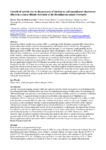Por favor, use este identificador para citar o enlazar este ítem:
http://www.alice.cnptia.embrapa.br/alice/handle/doc/982760| Título: | Growth of aerobic rice in the presence of biochar as soil amendment: short-term effects in a clayey Rhodic Ferralsol in the Brazilian savanna (Cerrado). |
| Autor: | CARVALHO, M. T. de M.  MADARI, B. E.   BASTIAANS, L.   VAN OORT, P.   HEINEMANN, A. B.   SILVA, M. A. S. da   MAIA, A. de H. N.   MEINKE, H.   |
| Afiliación: | MARCIA THAIS DE MELO CARVALHO, CNPAF; BEATA EMOKE MADARI, CNPAF; LAMMERT BASTIAANS, Wageningen University; PEPIJN VAN OORT, Wageningen University; ALEXANDRE BRYAN HEINEMANN, CNPAF; MELISSA ANANIAS SOLER DA SILVA; ALINE DE HOLANDA NUNES MAIA, CNPMA; HOLGER MEINKE, University of Tasmania. |
| Año: | 2012 |
| Referencia: | In: JOINT SSA AND NZSSS SOIL SCIENCE CONFERENCE, 5., 2012, Hobart. Soil solutions for diverse landscapes. Hobart: SSA: NZSSS, 2012. |
| Descripción: | Abstract: Increasing yields in aerobic rice systems (ARS) is a challenge in the Brazilian savannah (BS), where rice is grown under unfavourable conditions characterised by well drained and low fertile soils. Management options that could increase soil water availability and nitrogen (N) use efficiency would probably lead to higher grain yields in ARS. One promising option under consideration is the use of ?biochar?, a by-product of charcoal made of hardwood, as a soil amendment. Biochar is high in resistant (pyrogenic) carbon (70 to 80% of the material), which influences some processes in soil, depending on the amount applied and its interaction with the soil properties. Yet there are no conclusive field studies that quantify the effect of hardwood biochar application on grain yield of ARS in the BS. Here, we report single season effects of biochar application coupled with N fertilisation on aerobic rice growth and grain yield in a clayey Rhodic Ferralsol in the BS. At 72 days after sowing, leaf area index and total shoot dry matter of aerobic rice was negatively related to biochar rates above 16 Mg/ha. This effect might be related to changes in soil properties due biochar application, such as increased soil nitrate availability.We found that biochar applications did not influence grain yield. The effect of N fertilisation on yield followed a quadratic pattern, with an optimal N rate of around 46 kg/ha to achieve a grain yield above 3 Mg/ha, regardless of biochar application. The trends will guide future research. |
| Thesagro: | Oryza Sativa |
| Palabras clave: | Soil amendment Pyrogenic C char Ferralsol Pinthosol |
| Tipo de Material: | Artigo em anais e proceedings |
| Acceso: | openAccess |
| Aparece en las colecciones: | Artigo em periódico indexado (CNPMA)  |
Ficheros en este ítem:
| Fichero | Descripción | Tamaño | Formato | |
|---|---|---|---|---|
| 2014AA01.pdf | 294.01 kB | Adobe PDF |  Visualizar/Abrir |









